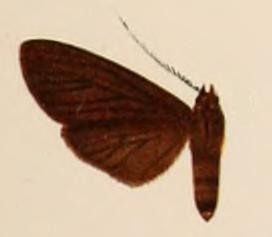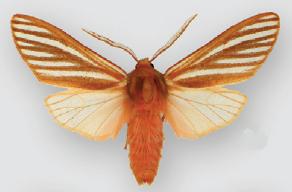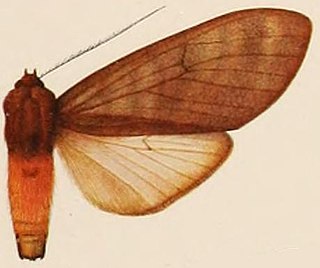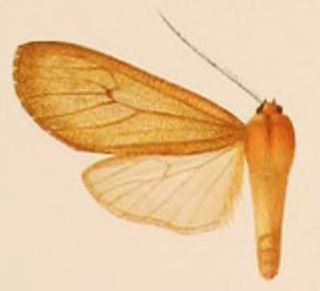
The Phaegopterina are a subtribe of tiger moths in the tribe Arctiini, which is part of the family Erebidae. The subtribe was described by William Forsell Kirby in 1892.

Amastus is a genus of moths in the family Erebidae. The genus was erected by Francis Walker in 1855.

Pelochyta is a genus of moths in the family Erebidae. The species was first described by Jacob Hübner in 1819. They are distributed in Africa, throughout India, Myanmar, Sri Lanka, Australia and New Britain.

Phragmatobia is a genus of moths in the subfamily Arctiinae described by Stephens in 1828. Many tiger-moth species of small and medium size were described within this genus. However, only a few are related to the type species.

Pseudohemihyalea is a genus of moths in the family Erebidae described by Régo Barros in 1956. While the caterpillars of most species of Pseudohemihyalea feed on broad-leaved trees, the P. ambigua group has larvae that feed on conifers. Their forewing coloration has accordingly evolved to light-and-dark lengthwise striping, giving better camouflage among the slim needles of the host plants. In this, they seem to be convergent to certain geometer moths, such as Caripeta piniata or Sabulodes niveostriata.

Amastus umber is a moth of the family Erebidae first described by Walter Rothschild in 1909. It is found in Venezuela.

Amastus rufocinnamomea is a moth of the family Erebidae first described by Walter Rothschild in 1909. It is found in Peru.

Amastus muscosa is a moth of the subfamily Arctiinae first described by Walter Rothschild in 1909. It is found in Peru.

Podalia is a genus of moths in the family Megalopygidae.
Amastus collaris is a moth of the family Erebidae. It was described by Gottlieb August Wilhelm Herrich-Schäffer in 1853. It is found in Venezuela, Peru, Colombia and Ecuador.
Amastus popayanensis is a moth of the family Erebidae. It was described by Rothschild in 1916. It is found in Colombia.
Amaxia perapyga is a moth of the family Erebidae. It was described by Walter Rothschild in 1922. It is found in Brazil.
Amastus cellularis is a moth of the family Erebidae. It was described by Walter Rothschild in 1922. It is found in Peru.
Amastus mossi is a moth of the family Erebidae. It was described by Walter Rothschild in 1922. It is found in Peru and Ecuador.
Opharus lehmanni is a moth of the family Erebidae. It was described by Walter Rothschild in 1910. It is found in Colombia.
Amastus modesta is a moth in the family Erebidae. It was described by Peter Maassen in 1890. It is found in Bolivia.
Cotana is a genus of moths in the family Eupterotidae.
Apodemia walkeri, or Walker's metalmark, is a butterfly in the family Riodinidae (metalmarks), in the superfamily Papilionoidea. The species was described by Frederick DuCane Godman and Osbert Salvin in 1886. It is found from north-western Costa Rica north through Mexico. It is an occasional visitor to the lower Rio Grande Valley in southern Texas. The habitat consists of subtropical scrubs and forests.





